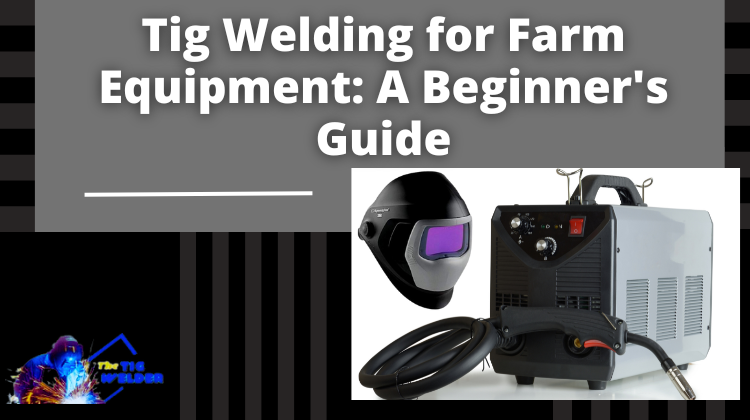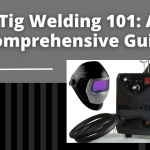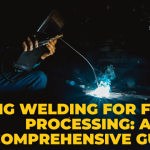Tig welding, also known as Tungsten Inert Gas welding, is a popular method of welding that is well-suited for farm equipment due to its precision and ability to produce high-quality welds. This type of welding is performed using a non-consumable tungsten electrode to produce the weld, and an inert gas, such as argon, to shield the weld area from contamination.
Tig welding is a versatile technique that can be used on a variety of materials, including steel and other alloys commonly used in the construction of farm equipment.

Tig Welding for Farm Equipment
Learn more about how tig welding can be used in the farm equipment industry; this beginner’s guide is for you. We will cover the basics of tig welding and provide tips and techniques for getting started.
Setting Up Tig Welding Machine
Choosing the right size and type of machine for your needs is essential for successful Tig welding. A machine with a power output of at least 200 amps is recommended for farm equipment. It is also important to consider the type of power source you will be using, as Tig welding machines are available in both AC and DC models.
In addition to the welding machine, you will also need to gather various supplies and tools. These may include electrodes, filler material, a Tig torch, and a ground clamp. Read the manufacturer’s recommendations for the specific materials and equipment you need.
Setting up your workspace is crucial for a successful weld. Make sure you have enough room to move around and position the machine and that the area is well-ventilated to dissipate fumes. It is also important to ensure that the machine is properly grounded and that all electrical connections are secure.
Preparing The Metal For Welding
Before you begin welding, it is important to properly prepare the metal surface. This may involve cleaning the metal with a grinder or wire brush to remove any dirt, rust, or other contaminants. You should also check for any holes or defects in the metal that may need to be filled or repaired before welding.
Selecting the right filler material and electrode is crucial for achieving strong, durable welds. The type of material you choose will depend on the type of metal you are welding and the job’s specific requirements. For example, aluminum requires a different filler material and electrode than stainless steel.
Setting the machine’s amperage and pulse rate is also important for ensuring a successful weld. The amperage, or current, controls the weld’s heat, while the pulse rate determines the frequency of the current. Experimenting with different settings and practicing on scrap metal can help you find the optimal settings for your particular project.
Performing The Weld
Set up your torch and tungsten electrode to begin the weld according to the manufacturer’s instructions. The tungsten electrode is a non-consumable rod that conducts the current and creates the arc between the metal and the electrode.
Striking an arc is the first step in the welding process. To do this, bring the tungsten electrode close to the metal and turn on the power. The arc will form when the tungsten touches the metal, and you can then move the torch along the joint to create the weld pool.
As you weld, it is important to maintain a consistent weld pool by adding filler material as needed. The filler material helps to create a strong bond between the two pieces of metal and helps to prevent cracks or other defects.
Once you have completed the weld, it is important to finish it properly by cleaning up any excess material and allowing the weld to cool. This will help to ensure the strength and durability of the weld.
Tips For Successful Welding On Farm Equipment
As with any skill, practice is key to becoming proficient at Tig welding. Here are some tips to help you achieve strong, aesthetically pleasing welds on farm equipment:
One common mistake is not properly preparing the metal surface before welding. Be sure to clean and prep the metal to ensure a strong, clean weld.
Another mistake is to be properly setting the amperage and pulse rate. Experimenting with different settings and practicing on scrap metal can help you find the optimal settings for your particular project.
To achieve a smooth, aesthetically pleasing weld, it is important to maintain a consistent weld pool and control the filler material as you weld. Practice makes perfect, so don’t be afraid to try different techniques and find what works best.
Proper maintenance of your welding machine is also crucial for successful welding. Follow the manufacturer’s recommendations for cleaning and maintaining your machine and troubleshooting any issues.
What Type Of Welder Is Best For Farm Use?
The type of welder best for farm use will depend on the specific welding tasks that need to be performed and the materials being welded. Some factors to consider when selecting a welder for farm use include the size and weight of the welder, its power output, its portability, and its versatility. For example, a portable MIG welder might be a good choice for welding small components or making repairs on the farm, while a larger, more powerful TIG welder might be better suited for more heavy-duty welding tasks.
What Is Tig Welding Best Used For?
TIG welding, also known as Gas Tungsten Arc Welding (GTAW), is a versatile welding process that can be used on many materials, including steel, aluminum, and copper. TIG welding is well-suited for thin welding sheets and small components, as it allows precise control over the weld and produces clean, visually appealing welds. TIG welding is often used in the aerospace, automotive, and medical industries, as well as in artistic and decorative applications.
Can A Generator Run A Tig Welder?
Some TIG welders can be powered by a generator, although this will depend on the generator’s size and power output and the welder’s requirements. TIG welders typically require a consistent and stable power supply and may not be compatible with all generators. It is important to check the specifications of both the welder and the generator to ensure that they are compatible and that the generator is capable of providing the necessary power.
What Type Of Welders Make 100k A Year?
Welders who are highly skilled and experienced in their field can earn salaries of $100,000 or more per year. However, the specific type of welding that a welder specializes in, the industry in which they work, and their location, can all impact their earning potential. Welders who work in high-demand industries, such as aerospace or shipbuilding, or who have advanced certifications or specialized skills may have higher earning potential than those who work in lower-demand industries or have less experience or education.
What Do Farmers Weld?
Farmers may use welding to fabricate or repair a wide range of equipment and structures on their farms, including tractors, trailers, and other machinery, as well as gates, fences, and other structures. Welding can be a useful skill for farmers to make repairs and improvements on their own rather than hiring someone else to do the work for them. Farmers may also use welding to create custom-built equipment or structures that are not readily available for purchase.
Conclusion
Tig welding is a valuable skill to have when it comes to repairing or fabricating farm equipment. Its versatility and precision make it a go-to choice for many professionals in the industry.
You can achieve strong, durable welds on farm equipment by following proper safety protocols, setting up your machine and workspace correctly, preparing the metal surface, and practicing good welding techniques.
With practice and dedication, you can become an expert at Tig welding and have the ability to tackle any welding project on your farm.

It’s been years since I got into welding as a side hustle. It’s been so long since Doing All kinds of welds for business and pleasure as this is my hobby. Being in this field I have learned from hands-on-experience also came to know what gears work and what doesn’t. The Tig Welder is my own platform where I use to share my experience.






Leave a Reply